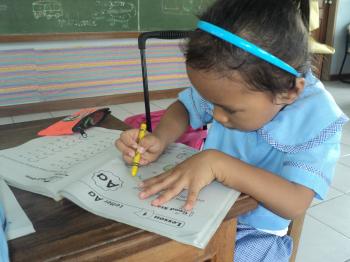
Vi er i Philippines
A growing population

Typhoon Haiyan damaged houses and the water tank in SOS Children's Village Tacloban (photo: SOS archives).
The Philippines has a population of over 105 million people (2013 est.). The capital city of Manila is home to 11.4 million. The country has one of the highest birth rates in Asia, and the population is growing fast.
An increasing number of people live in poverty
The people of the Philippines have experienced many social, political and economic changes in recent decades. Armed conflicts have also marked the lives of many; decades of fighting, much of which was against separatist groups and guerrillas, have claimed thousands of lives, displaced many more and curtailed opportunities for development.
In spite of the positive economic developments, the changes have not reduced poverty, and over 26 per cent of the population continues to live under the nationally established poverty line. Given that the population is increasing, there has actually been a rise in the number of people living in poverty. In addition, the wealth created has been unequally distributed. The lack of opportunities means that many people are forced to move overseas: around ten million Filipinos work abroad. The money they send home makes an important contribution to the national economy; it is estimated that it accounts for at least ten per cent of gross domestic product.
The current hardships and grim prospects make people vulnerable to the false promises of human traffickers. The Philippines is a recognised source, transit and destination country for the cross-border trafficking of women and children for the purpose of commercial sexual exploitation and forced labour.
In spite of the positive economic developments, the changes have not reduced poverty, and over 26 per cent of the population continues to live under the nationally established poverty line. Given that the population is increasing, there has actually been a rise in the number of people living in poverty. In addition, the wealth created has been unequally distributed. The lack of opportunities means that many people are forced to move overseas: around ten million Filipinos work abroad. The money they send home makes an important contribution to the national economy; it is estimated that it accounts for at least ten per cent of gross domestic product.
The current hardships and grim prospects make people vulnerable to the false promises of human traffickers. The Philippines is a recognised source, transit and destination country for the cross-border trafficking of women and children for the purpose of commercial sexual exploitation and forced labour.
Children's rights need to be protected

Please enter a caption
However, overall, Filipino children continue to face many difficulties. Tens of thousands of children are displaced by armed conflict and affected by natural disasters every year. In addition, the stresses of poverty have often led to a loss of parental care. About 11 per cent of children between the ages of five and 14 are forced to work. With one in every four children reporting to work through the night, it is no surprise that they struggle to keep up with their schooling.
The migration of parents in search of work has also affected children's lives. Children, who move with their parents to the cities, often end up living in informal settlements where they lack decent housing, food, sanitation facilities and potable water. UNICEF estimates that around 1.7 million children live in these poor conditions in Metro Manila alone.
SOS Children's Villages in the Philippines
The natural disasters, armed conflicts and political instability which the people of the Philippines have endured have led to an increase in the work of SOS Children's Villages over the past decades. We have responded to the needs of the local children, young people and families. For example, it has become increasingly clear that we need to support families and communities so that children do not lose parental care. Through the family-strengthening programmes, we have provided support to many households in the community. When children can no longer stay with their families, they are cared for by their SOS mothers in one of the SOS families. Young adults are given care and guidance by professionals so that they can learn to live a successful independent life.
In November 2013, Typhoon Haiyan caused great damage to SOS Children's Village Tacloban. The SOS families survived; they moved in with families in other SOS Children's Villages in the Philippines and slowly returned to Tacloban when their homes were rebuilt. We also provided urgent assistance to the local population. We provided temporary shelter and help rebuilt homes. We also provided nutritional and medical support. We created child-friendly spaces where local children could play and receive psychological support from our trained and experienced staff. We also worked hard to reunite families.
Website of SOS Children's Villages Philippines
(available in English)
In November 2013, Typhoon Haiyan caused great damage to SOS Children's Village Tacloban. The SOS families survived; they moved in with families in other SOS Children's Villages in the Philippines and slowly returned to Tacloban when their homes were rebuilt. We also provided urgent assistance to the local population. We provided temporary shelter and help rebuilt homes. We also provided nutritional and medical support. We created child-friendly spaces where local children could play and receive psychological support from our trained and experienced staff. We also worked hard to reunite families.
Website of SOS Children's Villages Philippines
(available in English)